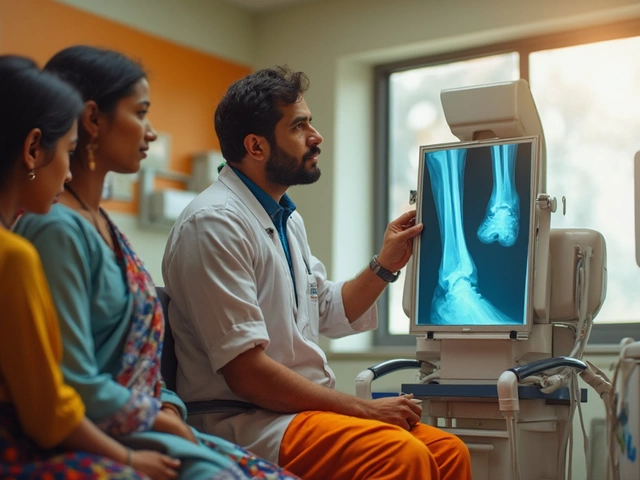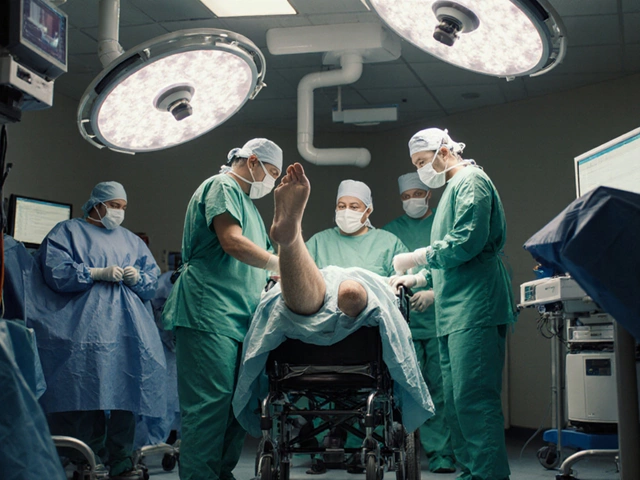If you've ever wondered which doctor to visit for your aching bones or tricky joints, you're not alone. We often hear terms like 'orthopedic specialist,' but what do they really do, and why are they the go-to experts for our skeletons? Let’s break it down.
Orthopedic doctors specialize in the musculoskeletal system, which is just a fancy way of saying they fix anything that has to do with bones, joints, ligaments, tendons, and muscles. Whether it's a sports injury, arthritis, or just a pesky knee, they're trained to help.
Now, how do you know when it's time to visit one? Well, if you’re experiencing joint or bone pain that's sticking around despite rest and over-the-counter meds, it's probably time to call in an expert. They not only treat common issues but also provide guidance on preventing future injuries.
- Understanding Orthopedic Specialists
- When to Visit an Orthopedic Doctor
- What to Expect During Your Visit
- Tips for Maintaining Healthy Bones and Joints
Understanding Orthopedic Specialists
So, what's the deal with orthopedic specialists? These doctors are like the superheroes of the bone and joint world, trained specifically to handle anything that involves the musculoskeletal system. This includes bones, joints, tendons, ligaments, and muscles. Essentially, they're the complete package when it comes to fixing anything that lets you move.
Most orthopedic specialists focus on one specific area, kind of like how your favorite pizza shop might specialize only in making perfect margheritas. You might find a doctor who deals only with hands, while another handles spinal issues. It’s this kind of expertise that sets them apart.
A fascinating fact is that even though we're born with around 270 bones, as adults we end up with 206. Some bones fuse together as we grow - orthopedic specialists spend years mastering these complexities to make sure our skeletons are in perfect form.
"An orthopedic surgeon is someone who knows how to solve difficult bone problems and make you move better again." - Dr. Lisa James, Renowned Orthopedic Surgeon
Types of Orthopedic Treatments
- Non-surgical treatments like physical therapy and medications are usually the first step.
- Surgical procedures might include repairing fractures, replacing joints, or correcting deformities.
- Preventative measures such as lifestyle recommendations are also crucial.
Sure, it sounds serious, but visiting an orthopedic specialist doesn't always mean surgery. They often employ less invasive techniques first. Did you know that many joint pains can be effectively managed with physical therapy alone?
Choosing the Right Orthopedic Specialist
Looking for an orthopedic specialist? Check if they're board-certified, which means they've passed rigorous exams and meet high standards. Also, consider their experience, especially if you have a specific issue. Personal referrals and online reviews can be super helpful too.
When to Visit an Orthopedic Doctor
When it comes to bones and joints, knowing when to see an orthopedic doctor can save you from a ton of discomfort and even prevent more serious problems down the line. So when's the right time to go?
Persistent Pain
If you've got pain in your joints or bones that just won't quit, and it's been hanging around for more than a couple of weeks despite taking it easy or popping some painkillers, it's time to see a specialist. Persistent pain is a major red flag.
Reduced Mobility
Struggling with movements you used to do easily? Whether it's bending your knee, turning your head, or flexing your elbow, reduced mobility can be a sign that something's off. An orthopedic doctor will figure out why you're stiff and how to get you back on track.
Injury or Trauma
Had a nasty fall, or does an old sports injury still nag at you? Orthopedic specialists deal with trauma from fractures to torn ligaments. Don’t brush it off; the sooner you address these injuries, the better the outcome.
Chronic Conditions
Conditions like arthritis, osteoporosis, or back pain might be manageable on your own at first. But when they're affecting your day-to-day life, it's time for professional help. Orthopedic doctors can offer treatments and lifestyle hacks tailored to your needs.
Unexplained Swelling
Notice swelling in a joint without a clear reason? Swelling could indicate inflammation, a sprain, or even an infection. Ignoring it is not an option if it doesn't go away soon.
| Condition | Common Symptoms |
|---|---|
| Arthritis | Joint pain, stiffness, swelling |
| Osteoporosis | Bone fractures, back pain |
| Fractures | Severe pain, inability to move |
Remember, your orthopedic health is important for keeping up with life's demands and enjoying the activities you love. So don't hesitate to make that appointment if you're facing any of these issues.

What to Expect During Your Visit
Wondering what'll happen when you visit an orthopedic doctor for the first time? It's normal to be curious—and maybe even a little anxious. But don't worry, I'll walk you through it so you know what to expect.
First things first: come prepared. Your doctor will kick off the visit with a bunch of questions about your medical history and the specific discomfort you’re experiencing. Make sure you’re ready to talk about any past injuries, previous surgeries, or ongoing health issues. If you have family members with bone or joint conditions, that's worth mentioning, too.
Initial Examination
Next, you'll have a physical exam. Your doctor will check the affected area for any swelling, tenderness, or unusual movements. They might also ask you to do some simple moves to see how your joints operate. This might not be the most comfortable part of the visit, but it’s super important.
Diagnostic Tests
To nail down the issue, they may order some diagnostic tests. X-rays are common since they provide a clear view of your bones, revealing fractures or alignment issues. In some cases, MRIs or CT scans are needed to get a better picture of what's happening inside the soft tissues.
According to Dr. Sarah Thompson, an orthopedic expert,
"Advanced imaging techniques offer invaluable insights, ensuring accurate treatment plans."
Discussion of Treatment Options
Once the diagnosis is clear, expect a discussion about treatment options. Treatments range from physical therapy and medication to more involved procedures like surgery. Your doctor will weigh the pros and cons of each choice and help you decide what works best for your lifestyle.
Here's a small tip: Don't hesitate to ask questions. Wondering how long recovery takes, or what side effects might occur? Definitely bring it up. Your orthopedic doctor is there to guide you through the entire process.
After the Visit
Before you head out, you might get some management tips or exercises to help you manage pain at home. Keep these instructions handy—they’re tailored just for you.
And there you have it! Visiting an orthopedic specialist might sound intimidating, but it's truly about getting you back on your feet—literally!
Tips for Maintaining Healthy Bones and Joints
Keeping your bones and joints in tip-top shape is something we can all benefit from. Here are some practical tips to ensure you’re doing just that.
Stay Active with Exercise
Regular physical activity is a game changer. Activities like walking, swimming, or cycling can strengthen the muscles around your joints, reduce stiffness, and improve balance. Just aim for about 30 minutes a day. Simple enough, right?
Eat Right for Bone Health
Your diet plays a huge role in maintaining bone density. Load up on foods rich in calcium and vitamin D, like dairy products, leafy greens, and fish. If you’re not getting enough from your diet, supplements can help too.
Watch Your Weight
Carrying excess weight puts extra pressure on your joints, especially the knees, hips, and back. Keep an eye on your weight to lessen the stress on these crucial parts of your body.
Don’t Skip Strength Training
Strength training isn’t just for bodybuilders. It can help maintain bone density. Lifting weights or using resistance bands a couple of times a week can make a big difference.
Prevent Injuries
Don't ignore minor injuries. Use protective gear when needed, like knee pads or braces if you’re playing sports. Always warm-up and cool down to prevent injuries.
Get Your Bone Density Checked
Especially as you get older, regular check-ups for bone density can spot issues before they become problematic. Talk to your orthopedic doctor about when it’s right for you.
A little knowledge goes a long way in keeping your bones and joints healthy. Stay informed, live actively, and eat wisely to ensure your body keeps moving the way it should.






